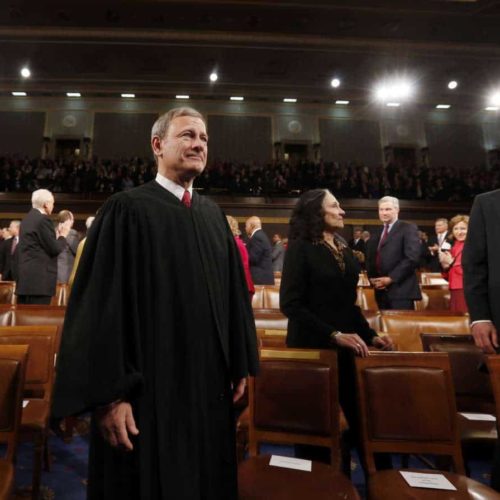Introduction
It is clear from both the first paragraph and closing comments in the Supreme Court’s decision upholding Obamacare subsidies that the justices listened more closely to the insurance industry than perhaps any other party.
In an amicus brief it filed with the court in King v. Burwell, America’s Health Insurance Plans, the industry’s main trade group, painted a dire picture of what would happen to the private health insurance market—and to people who cannot enroll in an employer-sponsored health plan—if the court ruled in favor of the plaintiffs. According to AHIP, under that scenario, you could pretty much kiss the private health insurance industry goodbye in two-thirds of the states.
The plaintiffs argued that because of the way the Affordable Care Act was worded, the government was unlawfully providing financial help to millions of people in 34 states— the states that had defaulted to the federal government to operate their health insurance marketplaces, or exchanges, rather than set one up on their own.
A sentence in one section says the subsidies will be made available through the exchanges “established by the state.” Members of Congress who wrote the law insisted they never intended for the subsidies to be available in just the states that set up their own exchanges. But attorneys for the plaintiffs insisted that the justices should interpret those four words literally (and out of context).
They asked the Court to strike not only the subsidies in the 34 states that didn’t set up their own exchanges —but also the law’s requirement that most Americans must buy coverage or pay a penalty. The plaintiffs, however, did not ask the court to strike another provision: one that makes it illegal for insurance companies to refuse to sell a policy to any applicant willing to pay.
A victory by the plaintiffs would have created a situation in which many of the newly insured—especially low- and moderate-income individuals in good health—would have dropped their coverage. Without the subsidies many of them have been getting from the federal government since January 2014, they wouldn’t be able to afford the premiums. Had the plaintiffs prevailed, the only people who could be expected to continue buying coverage in the individual market in those 34 states would be those with conditions requiring expensive care.
AHIP wrote in its brief that without the mandate to buy insurance, young and healthy people would once again opt to go uninsured, leaving the marketplace to sicker and older consumers. AHIP wasn’t just blowing smoke; the trade group noted what happened a few years back when New York and several other states tried to force insurance companies to accept all applicants without a mandate to buy coverage. Premiums in every one of the states spiked dramatically and almost immediately. Most insurers quit selling policies in those states because of this developing “death spiral.”
Cigna, where I worked, was one of many insurers worried that Congress might consider doing what New York did. Back then, I wrote a policy brief stressing the necessity of requiring people to buy coverage if insurance companies were required to take all comers.
Roberts, for one, paid keen attention to AHIP’s brief. Here’s how he began the majority decision:
“The Patient Protection and Affordable Care Act grew out of a long history of failed health insurance reform. In the 1990s, several States sought to expand access to coverage by imposing a pair of insurance market regulations—a ‘guaranteed issue’ requirement, which bars insurers from denying coverage to any person because of his health, and a ‘community rating’ requirement, which bars insurers from charging a person higher premiums for the same reason. The reforms achieved the goal of expanding access to coverage, but they also encouraged people to wait until they got sick to buy insurance. The result was an economic ‘death spiral’: premiums rose, the number of people buying insurance declined, and insurers left the market entirely.”
He went on to note that in 2006, “Massachusetts discovered a way to make the… requirements work—by requiring individuals to buy insurance and by providing tax credits to certain individuals to make insurance more affordable. The combination of these three reforms—insurance market regulations, a coverage mandate, and tax credits—enabled Massachusetts to drastically reduce its uninsured rate.”
What Roberts didn’t say was that those three reforms came straight out of the Republican reform playbook, or at least their pre-Obamacare playbook. It was former GOP presidential nominee Mitt Romney who helped devise the Massachusetts plan when he was governor there.
Roberts also did not claim he was saving Republicans from themselves, but that is what he did. The reality is that, despite their insistence on repealing and replacing Obamacare, Republican lawmakers have not been able to offer a workable alternative. They boxed themselves in by condemning their best reform ideas because Obama and Congressional Democrats adopted them. The fact is, they’ve got nothing new that will help to bring down health care costs and expand coverage.
Roberts summed up his rationale for agreeing with the government with this sentence toward the end of his decision:
“Congress passed the Act to improve health insurance markets, not to destroy them.”
Exactly. And he knew that, despite the GOP Sturm und Drang about Obamacare, if they actually got what they wished for, they would, indeed, destroy those markets.
Wendell Potter is the author of Deadly Spin: An Insurance Company Insider Speaks Out on How Corporate PR is Killing Health Care and Deceiving Americans and Obamacare: What’s in It for Me? What Everyone Needs to Know About the Affordable Care Act.
Read more in Health
Health
More Medicare Advantage audits reveal overcharges
Researchers say government secrecy thwarts efforts to fix payment scheme
Wendell Potter commentary
Coming health insurance mergers will cost consumers
Commentary: talk of ‘eliminating redundancies’ really means layoffs


Join the conversation
Show Comments